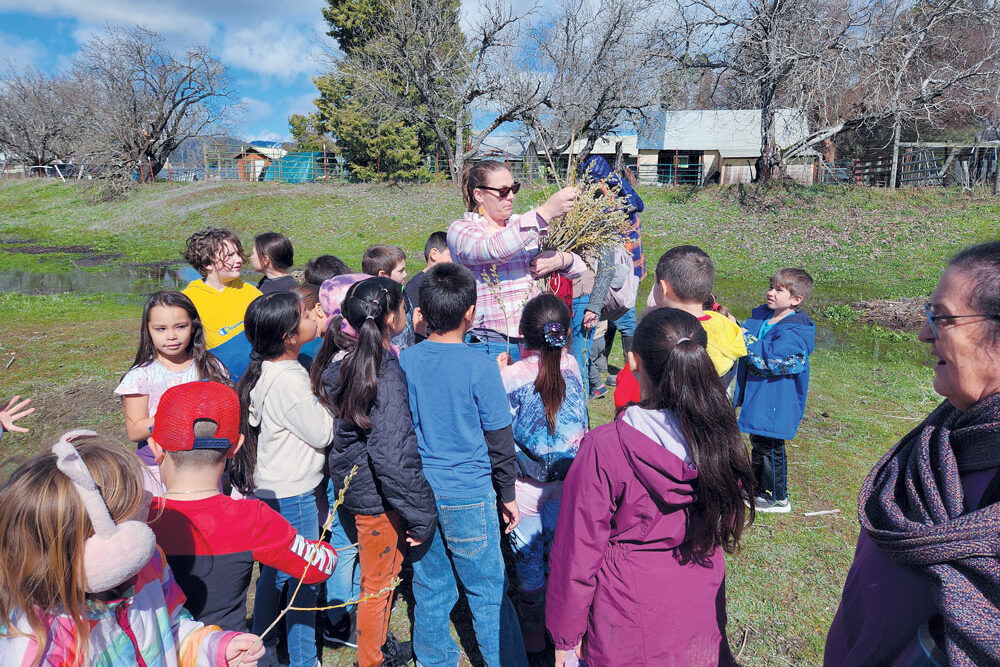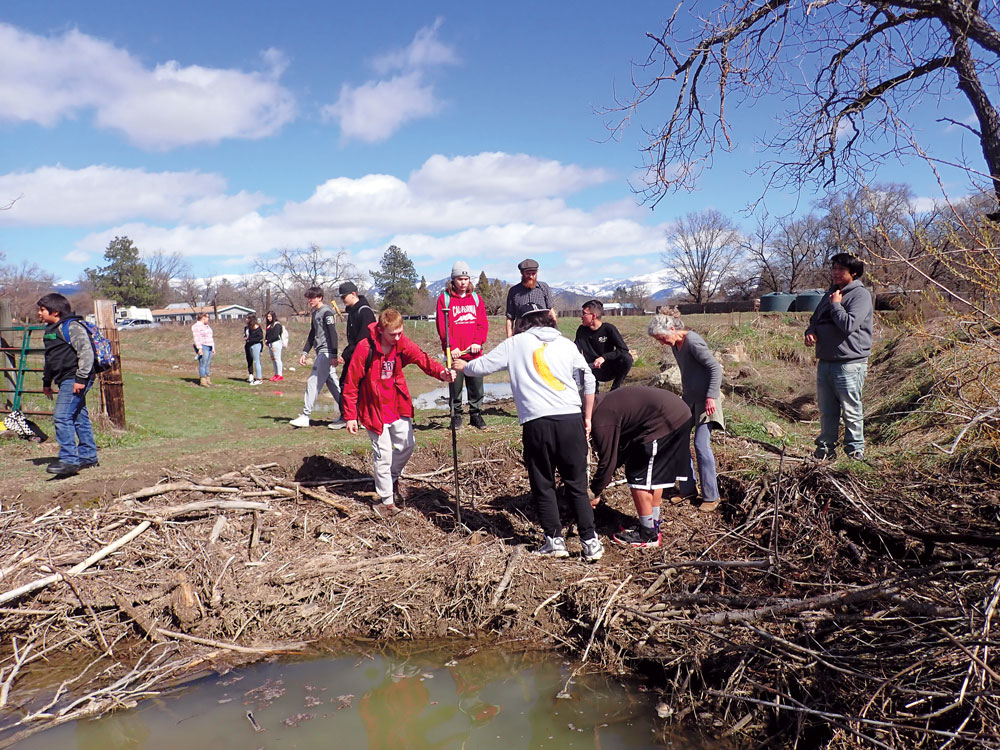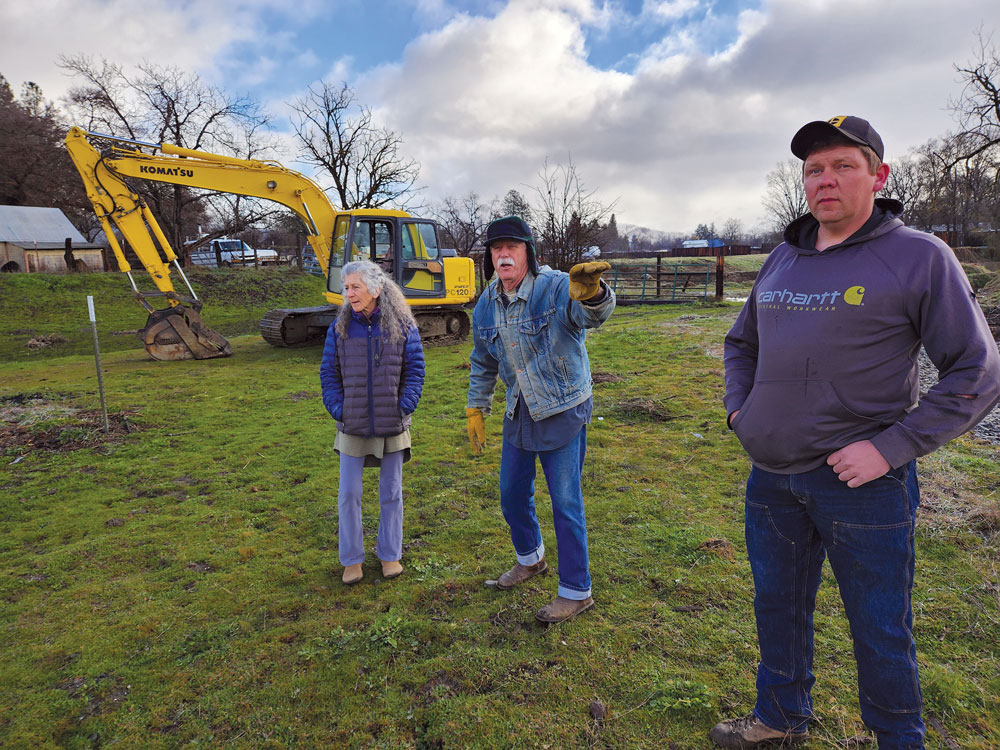Willow Walls, Cottonwood Containment, and Flood Control

Town Creek Restoration Project in Covelo Gives Round Valley Students Hands-On Experience
By Eel River Recovery Project
In 2021, the Eel River Recovery Project (ERRP) was awarded a grant from the Department of Water Resources’ (DWR) Urban Streams Restoration Program (USRP) for work in Covelo in northeast Mendocino County. The Town Creek Restoration and Education Project originally aimed to intensively treat one site by building a large-scale bioengineering structure with imported boulders and large wood. It now features a low-tech approach using mostly living willow, and the effort is fully involving students from nearby schools and the community.
Until the mid-1980s, the Round Valley County Water District (RVCWD) was allowed to use heavy equipment to excavate excess gravel from Mill Creek and its tributaries—Town, Grist, and Short Creeks—to maintain flood-control capacity. Since the cessation of channel clearance, due to extensive regulation changes, berms that once confined the flow have been washed out, and major bank erosion has taken place. A site on Town Creek below Airport Road has acute bank-erosion problems. The channel has widened to 300 feet and has long-term potential to re-route and create major problems for Covelo.
The recently implemented grant was initially conceived in 2019 when the RVCWD requested that ERRP consider filing for a DWR USRP grant to treat the Town Creek Airport Road site. After landowners confirmed the need and willingness to participate, ERRP recruited BioEngineering Associates to design and build a project to remedy bank erosion and create improved fish habitat. Once the project opened in April 2021, DWR imposed requirements for perpetual easements and deed restrictions that were not acceptable to the landowners, who then pulled out of the agreement in early 2022. The project then changed to planning and permitting only.
Eric Austensen of Streamline Engineering joined the ERRP team in late 2022. He pointed out that there needs to be system-wide flood planning because channel constraints downstream of the restoration site could back up floodwaters and promote continuing aggradation and flood risk. He offered a design alternative that would use no imported large rock or large wood, and instead incorporate willow branches/shoots and stream aggregate. A major thrust of the project is involving students from nearby Round Valley Elementary School (RVES) and Round Valley High School (RVHS) in a meaningful way.

Connecting Round Valley Students to the Town Creek Restoration
ERRP Outreach Coordinator Lourance Hall and educational consultant Viviana Field are working closely with RVES teachers and classes. Viviana is leading projects that focus on art with younger students (K-3) and building a watershed model with middle-school students. The artwork and model will be on display at the Covelo Library Commons as part of the 2023 Earth Day celebration, which will include a hosted open house on Friday, April 21st.
Lourance has established excellent working relationships with RVHS teachers. Classes have featured presentations from ERRP Managing Director and fish biologist Pat Higgins and restoration specialist Chris Tebbutt. High school students can help with restoration planning and implementation as part of school projects, in association with Future Farmers of America (FFA) programs.
Pat Higgins and Chris Tebbutt have been friends for 30 years, and during that whole time, Chris and his wife Stephanie have been restoring Anderson Creek—which runs through their organic farm near Boonville—using willow and deep-planted cottonwoods. When Pat asked Chris if he would help teach students (and the community) about deep-planting cottonwoods as part of a Town Creek demonstration restoration project, Chris jumped at the chance. He and Stephanie would bring native willow and cottonwood poles from Anderson Valley to Covelo if an excavator operator could be lined up. Lourance connected ERRP with expert excavator operator Chance Hart, and plans were made with landowner Jimmy Durall to plant an area 60 feet by 20 feet. Stephanie and Chris arrived with enough cottonwood and willow poles to span the 350-foot width of the parcel, and when they asked for permission, Jimmy gave the OK!

The Pieces Come Together
After delaying the project for a week due to snow at the restoration site, the deep planting of cottonwood and willow was successfully carried out on Friday, March 10. The clouds parted to reveal snow-covered hills, rainbows formed in the morning mist, and later in the afternoon it was tee-shirt weather. More than a dozen classes from RVES and RVHS came to watch as 15-foot-long cottonwood and willow poles were deeply planted. Deep planting allows roots to sprout and extend down into the water table, making it unnecessary to irrigate them.
Students pitched in by helping stage the poles in a small pond in the pasture to keep them wet. Then they shoveled aggregate that the excavator had left on grassy areas into the holes where trees were planted. Students were also taught about willow planting, including gathering willow cuttings, shoving sprigs in the eroding wet banks, and pounding stakes into wet areas of the gravel bar on the stream margins. In total more than three dozen willow and cottonwood poles and 125 willow stakes were planted.
The use of willow and cottonwood is inexpensive and could be employed by riparian landowners anywhere in Round Valley without a permit, if they are not operating in the channel. The RVCWD believes this approach could be exported and mimicked at other sites as the District, ERRP, and RVIT continue to plan and implement restoration across the Round Valley floor.
Lessons in Mapping
Students will be taught how to use the Avenza Maps app to map where cottonwoods are with the assistance of ERRP contractor Noel Soucy of Soucy Biologique. They will also make a map of where car bodies and truck tires have been used to stabilize banks in the past so that these can be removed and the riparian zone restored. Noel will turn GPS data into maps and posters for display at schools and community meetings. The maps will be included in the project’s Final Report, which will be used to help secure future funding.
For more information, call Lourance Hall at 707/972-3637. See the ERRP website (eelriverrecovery.org) or Facebook page (facebook.com/EelRiverRecovery/).
